
Alfalfa, barley, soybeans, and other summer cover crop experiments
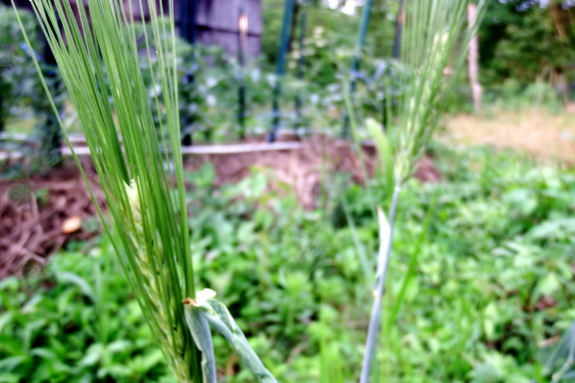
Preliminary results are trickling in from this year's cover-crop experiments.
I'll start with the least successful --- barley. Barley works fine as a
fall-planted cover crop, assuming you have a way to kill the
overwintering plants in the spring. And I'd read that you can also plant
barley in spring as an early ground cover that heads up in time to let
you plant summer vegetables afterwards. Unfortunately, I didn't give the
species a very good test.
The barley pictured above went into the bare soil of the forest garden aisles,
which had been dug down to near the level of the groundwater in order
to mound up the surrounding beds. But soon after planting in early
April, the aisles flooded and (I suspect) killed emerging seedlings.
After that, our weather took an extreme turn in the other direction and
turned hot and dry, making for bad spring-crop conditions.
I did plant another test
bed in the main garden, but, unfortunately, that bed fell prey to Mark's
weedeater. In his defense, baby barley looks just like grass. And I
hadn't done a good job of weeding that area yet this spring, so my
long-suffering husband wasn't entirely sure where the aisles ended and
the beds began. To cut a long story short --- most of the barley planted
there didn't manage to regrow and the bed instead went to weeds.
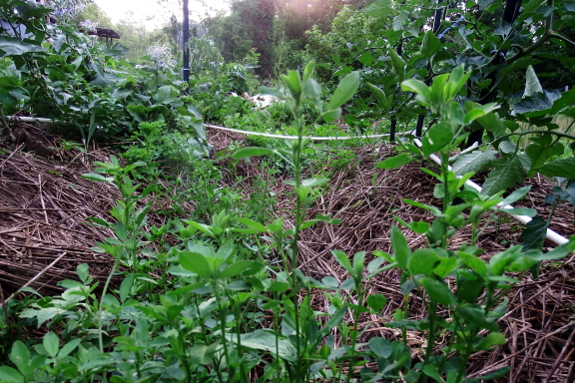
I planted alfalfa at
about the same time and in about the same place, but with more
trepidation. However, to my surprise, the legume turned out to be much
more hardy than the grain. The forest-garden aisle of alfalfa had to
deal with the same flooding-then-parching conditions, and the control
bed in the front garden also got accidentally mowed. But alfalfa in both
spots managed to resprout and make at least a moderate stand. In fact,
in areas where I planted alfalfa and protected them from the weedeater,
the cover crop nearly looks ready to be cut as a come-again mulch
producer. Not bad work for two months of growth!
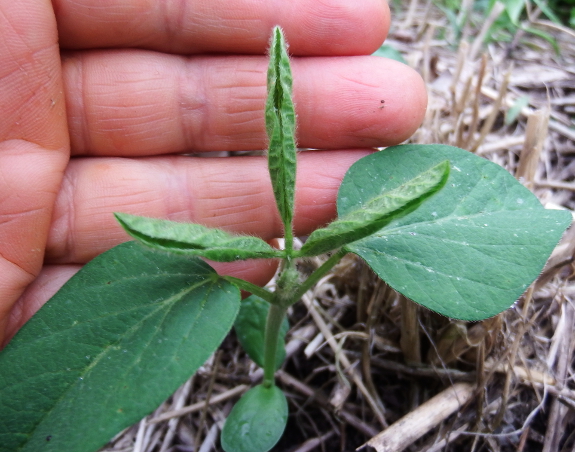
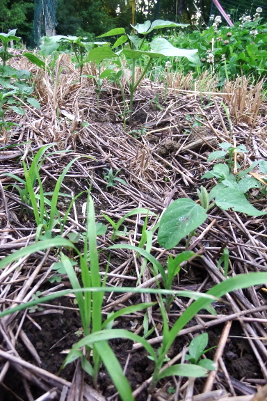 Legumes
are one of the themes of this summer as well. Sure, I largely depend on
animal manures to add nitrogen to our garden, but it never hurts to
have a vegetative source of the high-demand nutrient. So I'm trying out
soybeans in several locations ranging from rye stubble in prime soil
beds to the pure clay that has been recently solarized. I'll keep you posted about the results.
Legumes
are one of the themes of this summer as well. Sure, I largely depend on
animal manures to add nitrogen to our garden, but it never hurts to
have a vegetative source of the high-demand nutrient. So I'm trying out
soybeans in several locations ranging from rye stubble in prime soil
beds to the pure clay that has been recently solarized. I'll keep you posted about the results.
In the photo to the
right, you can actually see three different cover-crop species if you
look closely. In addition to soybeans and scarlet runner beans
(to train onto the trellis not visible above the picture), I also
interplanted both millet and sorghum-sudangrass in this bed. I'm not
sure whether the millet is actually coming up, but the
sorghum-sudangrass is growing, albeit slowly. More on these warm-season
grasses as the season progresses.
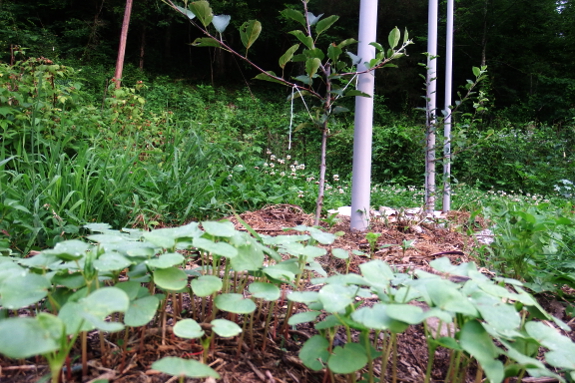
Finally, I'd be remiss if
I didn't mention my favorite summer cover crop, the old standby
buckwheat. This non-grassy grain managed to sprout despite our recent
drought and is pictured above filling in empty bed areas between young
apple trees. Honestly, I wouldn't be at all surprised if, after trying
six new species in 2015, I plant all buckwheat again next year. But stay
posted for updates as they come down the pike!
Want more in-depth information? Browse through our books.
Or explore more posts by date or by subject.
About us: Anna Hess and Mark Hamilton spent over a decade living self-sufficiently in the mountains of Virginia before moving north to start over from scratch in the foothills of Ohio. They've experimented with permaculture, no-till gardening, trailersteading, home-based microbusinesses and much more, writing about their adventures in both blogs and books.
Want to be notified when new comments are posted on this page? Click on the RSS button after you add a comment to subscribe to the comment feed, or simply check the box beside "email replies to me" while writing your comment.

I can't recall having seen you mention trying or considering oilseed radish as a cover crop, but I thought I'd mention it because many small-scale vineyards use it. The roots naturally break up heavily compacted or clay-heavy soil and they also act as natural accumulators of a lot of micronutrients that are often lacking in the worst soil. They also are pretty good at out-competing weeds.
Vineyards typically till up the top few inches of soil to kill the crop (which I know is not an option for you), but I can't help but wonder if there might be a way to integrate them in to at least some parts of your weed control/soil improvement regimen. Might be worth some investigating.
Dave --- Oilseed radishes are a great no-till cover crop! In fact, they're among my top five favorites and I wrote about them in depth in Homegrown Humus. But they're really a fall/winter crop, not a summer crop, which is the niche I'm talking about in this post.
(By the way, if you type a term like "oilseed radish" into the search box in the sidebar, you'll see all of our posts on the topic.)
Kiina --- I haven't tried to harvest buckwheat from our plants. But from what I've read, the difficult part will be harvesting and then breaking the hull of the seed. I recommend these two books for further information: Small-Scale Grain Raising and Home-grown Whole Grains. Good luck!
Brian --- You might get lucky and have a naturally reoccurring winter cover crop the way my father does. I hope you'll keep me posted on weed pressure as the clover resprouts. I always wonder how much it competes with the vegetables you grow in between.